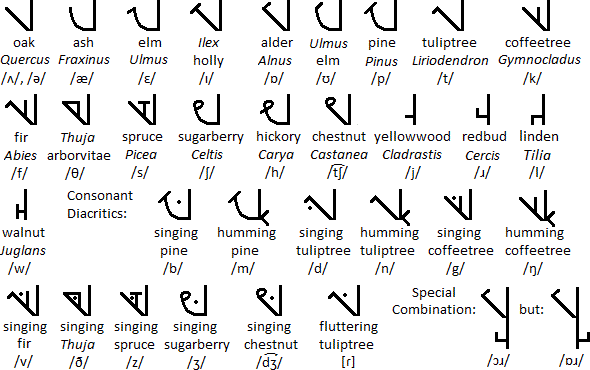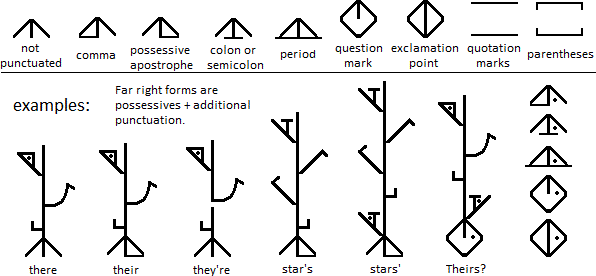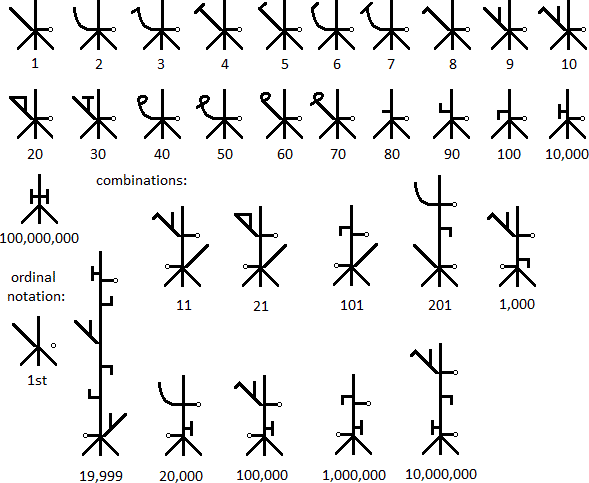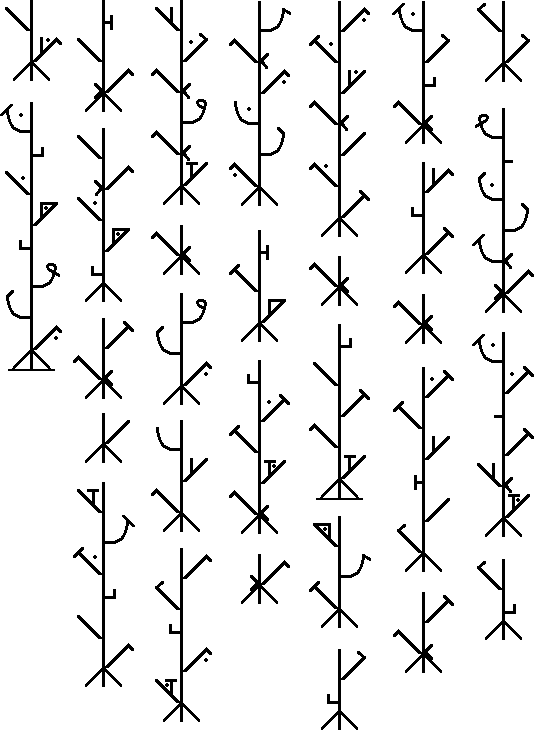Oakscript was initially devised by Brandon Williams to write a family of conlangs he is developing (the Aralát languages). In the process, he noticed that it could easily be adapted for his own dialect of Midland American English. The shapes of the writing system were inspired by the scrubby, spindly oaks (turkey oak, blackjack and bluejack oak, sand post oak) which are so common in the coastal plain of the southeastern United States. Each word is meant to resemble a tree, at least in an abstract sense. Oakscript also took inspiration from the traditional Mongolian script and Devanagari.
Each letter is named after a genus of tree, usually the common name of the genus, but in a few instances the scientific name. In the alphabet table below, both the common and scientific name of the genus are given, and the first name listed is the one used for its sound (elm is actually used twice, with the common, then with the scientific), using the acrophonic principle. This means that the name for each letter begins with the sound that letter symbolizes, though in this case regardless of voicing or nasality. For example, “pine” represents the phoneme /p/, but is also used, with diacritics, to indicate /b/ or /m/.
The script has its own phonetic terminology, so that /b/ is referred to as “singing pine” and /m/ as “humming pine”; voiced sounds except nasals are “singing” sounds, nasals are “humming” sounds. Voiceless sounds are “whispered” sounds, and the basic forms of the stops, fricatives, and affricates are voiceless, so for example all “pines” without diacritics are technically “whispering pines”, though this would not usually need to be stated explicitly. Similarly, all vowels are “singing”, e.g. “singing oak”, so there is no ambiguity in simply omitting the longer forms. Only the disambiguating full forms are given in the following table. Additionally, the alveolar tap [ɾ] allophone of /t/ and /d/ is distinguished diacritically.
For the sake of acrophony, Ilex and Ulmus should be pronounced more like /ˈilɛks/ and /ˈʊlmʊs/, respectively. Oakscript reflects the caught-cot merger of its developer, so there is only one low back vowel symbol (“alder”, which may be either rounded or unrounded). /ɔ/ only occurs before /ɹ/, and this necessitates the sole exception to the “180° reflecting rule” mentioned above. The sequence /ɒɹ/ follows the normal pattern. Note the bottom right of the table. Finally, sugarberry is properly a species of hackberry, but /ʃ/ was needed.

Some diphthong combinations yield a slightly different pronunciation than their constituent parts would suggest. /i/ and /u/ are generally slightly diphthongized to [ɪi̯] and [ʊu̯] in Midland American English (as well as many other dialects), and the script takes advantage of that fact. L-vocalization: before a consonant or in word-final position, “linden” is replaced by “alder”, essentially forming a diphthong with the preceding vowel (note the last example on the right).

The “apostrophe” is only used in possessive forms, regardless of whether the possessive form has an apostrophe in standard English orthography. In the possessive singular of nouns, only the “apostrophe” is added and “spruce” is omitted, otherwise the possessive singular and plural would be orthographically ambiguous. One could say that in this particular instance, the “apostrophe” has a phonetic value /s/ or /z/. Contractions are simply written with a small space where an apostrophe would exist in standard orthography.

The numerals are fairly straightforward in premise. They are simply the letters of the alphabet with a special diacritic, and follow the alphabetic order, with lower values at the beginning and higher values towards the end. Note, however, that the letter with the value of 70 does not appear in the alphabet. Its place in the order is maintained from the original conlang usage of the script, wherein it represents an alveolar affricate /ts/. Here it could be called Tsuga (hemlock, a genus in the pine family).


All human beings are born free and equal in dignity and rights. They are endowed with reason and conscience and should act towards one another in a spirit of brotherhood. (Article 1 of the Universal Declaration of Human Rights)
Brandon may be contacted at bwilli701@gmail.com for any questions pertaining to the script.
Constructed scripts for: Ainu | Arabic | Chinese languages | Dutch | English | Hawaiian | Hungarian | Japanese | Korean | Lingala | Malay & Indonesian | Persian | Tagalog / Filipino | Russian | Sanskrit | Spanish | Taino | Turkish | Vietnamese | Welsh | Other natural languages | Colour-based scripts | Tactile scripts | Phonetic/universal scripts | Constructed scripts for constructed languages | Adaptations of existing alphabets | Fictional alphabets | Magical alphabets | A-Z index | How to submit a constructed script
[top]
You can support this site by Buying Me A Coffee, and if you like what you see on this page, you can use the buttons below to share it with people you know.

If you like this site and find it useful, you can support it by making a donation via PayPal or Patreon, or by contributing in other ways. Omniglot is how I make my living.
Note: all links on this site to Amazon.com, Amazon.co.uk
and Amazon.fr
are affiliate links. This means I earn a commission if you click on any of them and buy something. So by clicking on these links you can help to support this site.
[top]